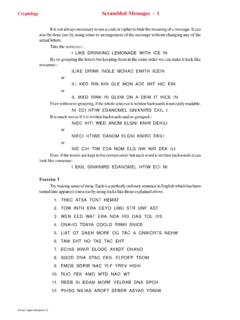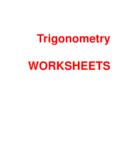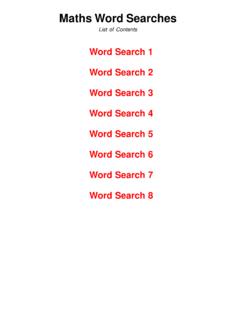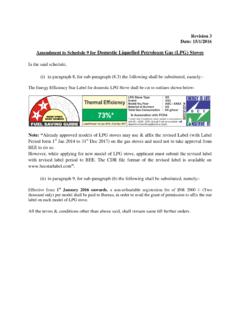Transcription of Teacher Resources on Line - Cleave Books
1 Tangrams Tangrams are puzzles of a type known generally as dissections. That is, one shape is cut into pieces, and the pieces are re-arranged to make another shape. In the most general case, the starting and finishing shapes can range from the regular to the highly irregular, and the manner in which the cutting is to be done may be prescribed or not. In the particular case of Tangrams, the starting shape is a square and the way it has to be cut is defined; while the shapes which have to be made are varied. Tangrams are an excellent exercise for the classroom, providing a lot of pleasureable practice in 2-dimensional spatial work. The seven pieces into which the original square is dissected are simple but, in use, provide ample opportunities for the need to see relationships between the different shapes and their sizes. There is much turning-around and turning-over to make them fit together to form the required shape. How this work is to be done in the classroom context will be very dependent on local conditions.
2 It could be a single lesson; or a set of lessons (consecutively or at regular intervals); or an on-going project; or something which, after an introduction, could be used to set a homework occasionally. As always in these matters, it must be the judgement (and enthusiasm) of the Teacher which governs those decisions. First of all a set has to be made. This can be done in a variety of ways. Pupils make their own entirely from scratch, given only the necessary card and tools, and a copy of the introductory sheet headed Working with Tangrams'. (Cereal packets are an inexepensive source of stout card.). Pupils could be given a pre-drawn grid which has been photo-copied onto card and then need only the introductory sheet to see how to mark out the grid. (Or step by step instructions given via an ohp.) The sheet headed Polygam Grids' would serve as a master copy, or something similar could be drawn if a smaller square is required. Pupils could be given a pre-drawn Tangram square, photo-copied on to card, ready for cutting-up.
3 Two alternatively-sized sheets for master copies are provided here. Just what has to be done in solving these puzzles is fairly easy to understand and, once the pieces are made, work could start almost immediately on the puzzle sheets (1 to 6), starting at an appropriate level. However, an opportunity to talk about and demonstrate some points could be done on the ohp. A large outline figure is given for this purpose. It is based on the Tangram set from the 8 cm square, and the solution is given (as a reminder) in the bottom left-hand corner. The fact that the only piece which need ever be turned over is the parallelogram could be established here. Brief accounts on the puzzle sheets follow. Traditionally the puzzles are printed in solid black but, since recording is an important part of these exercises, the shapes have (mostly) been given in outline for filling-in. Tangram Puzzles 1 has only 2 shapes, both given in solid back and in outline Tangram Puzzles 2 has 4 shapes, all in outline.
4 Both sheets 1 and 2 are comparatively easy since several individual pieces can be seen and put in place before tackling the bulk of the shape with a fewer number of pieces. These puzzles can also be solved (with a 6 cm set) by laying the actual pieces on the given outlines. This is often a help for those who have trouble in working with images on two different scales, when the puzzle-shape is one size, and the Tangram set in use is a different size. Tangram Puzzles 3, 4, 5 are made with smaller-sized Tangram sets and generally are of increasing difficulty as the number of obvious pieces decreases. Tangram Puzzles 6 has 13 shapes, all printed in black and none of them has any obvious pieces. It also offers an extra challenge in that the outline of the shape now has to be drawn, as well as the internal dispositon of all the pieces. A well-drawn diagram is difficult for many to achieve. No solutions are provided here, but they are not that difficult.
5 One of the recommended Books might help. Some ideas for projects or specific tasks (group or individual) are Form your name or initials in Tangrams. Design a particular letter, number or alphabet. Make a Tangram picture for some ordinary object (kettle, wheel-barrow, car, aeroplane .. ). Illustrate a story with Tangram pictures. Make a poster on some particular theme (zoo, circus, theatre, sport .. ). A point that does need making in connection with all of the above is the need to match the size of the Tangram (as measured by the edge-length of its original square) to the work being done for best-looking results. This is particularly necessary when making a collection for some purpose. A good example of what should be avoided is at the top of Tangram Puzzles 4. That rabbit and house would look ridiculous if put together in the same story! Inventing Tangram shapes to show real-life objects is not easy. To overcome this and encourage work of the nature outlined above, it is recommended that some source of Tangram pictures is available.
6 A useful book for this is Tangrams 330 Puzzles by Ronald Read, Dover Publications. ISBN 04862 14834. There are also several sites on this topic to be found on the Web, and the best way of locating these is to go to (which is a search-engine) and ask for tangrams - it finds hundreds of sites! The site at provides lots of actual Tangram shapes as well as links to other sites. Finally, to see what can be done when Tangrams get animated go to Extensions and Variations As if all that were not enough, you can invent your own variation on the Tangram idea. Below are some examples of other ways in which the basic 4 by 4 grid can be marked and cut. The first four were made and marketed at some time under the names given. Note that the Tormentor has 8 pieces, the others have 7. Not surprisingly, many of the Tangram puzzles can also be solved with these. The Sixagram is a 6-piece dissection (of the 4 by 4 grid) which was invented in a classroom. The Cross Breaker is based on a 5 by 4 grid of squares (7 pieces again) and was also marketed commercially.
7 Tangram Chie No Ita Pythagoras Tormentor Sixagram Cross Breaker Frank Tapson 2004 [trolXK:2]. And then there are dissections of circles .. Working with Tangrams To make a set of Tangram pieces Use a piece of card. On it mark out a square. An edge length of 6 or 8 cm is a good size to use. Draw a 4 by 4 grid of squares inside the big square. Draw the lines lightly as these are only needed as guides. Using these guide-lines, and with the diagram on the right as a pattern, draw in another set of lines. These are the cutting lines. Cut the square up into 7 separate pieces. These 7 pieces are the full set of Tangrams. The set of 7 (shown below) is made up of 2 large triangles 1 medium triangle 2 small 1 square triangles 1 parallelogram A typical Tangram puzzle is shown on the left, where the 7 pieces have been used to make a picture of a yacht. Sometimes the picture is drawn in outline, as in the middle picture. No matter how it is presented, the puzzle is to find out how the 7 pieces were arranged.
8 The solution is shown on the right. Remember that ALL 7 pieces must be used to make the picture. Frank Tapson 2004 [trolXK:3]. Tangram Puzzles ~ 1. Use the outline pictures to draw in the arrangement of the 7 Tangrams used to make the black pictures. Runner Indian chief Frank Tapson 2004 [trolXK:4]. Tangram Puzzles ~ 2. Complete the outlines given to show how the 7 Tangrams can be used to make each of these pictures. Young girl Cat Horse and rider Lady with handkerchief Frank Tapson 2004 [trolXK:5]. Tangram Puzzles ~ 3. Complete the outlines given to show how the 7 Tangrams can be used to make each of these pictures. Swan Stork Three Shoe Lighthouse Four Frank Tapson 2004 [trolXK:6]. Tangram Puzzles ~ 4. Complete the outlines given to show how the 7 Tangrams can be used to make each of these pictures. Rabbit Boating House Chevron Motif Goose Shark Vulture Archway Letter G Mr Bean Frank Tapson 2004 [trolXK:7]. Tangram Puzzles ~ 5. Each of the separate shapes in the pairs given here must use ALL of the 7 Tangram pieces.
9 Hey there's something wrong with you! . Bridges Chairs Gossip Candle lit & unlit Woman with pram Frank Tapson 2004 [trolXK:8]. Tangram Puzzles ~ 6. Trapezium 1 Trapezium 2. Trapezium 3. Hexagon 1. Hexagon 2 Hexagon 3. Pentagon 1 Pentagon 2. Parallelogram Oblong Square Right-angled isosceles Square minus triangle a square Frank Tapson 2004 [trolXK:9]. Polygram Grids Frank Tapson 2004 [trolXK:10]. Tangrams (8 cm set). Frank Tapson 2004 [trolXK:11]. Tangrams (6 cm set). Frank Tapson 2004 [trolXK:12]. Polygram Grid Frank Tapson 2004 [trolXK:13]. Tangram Puzzle ~ The Giraffe Frank Tapson 2004 [trolXK:14].















